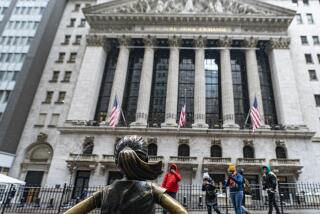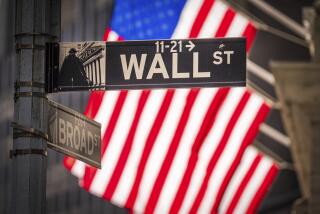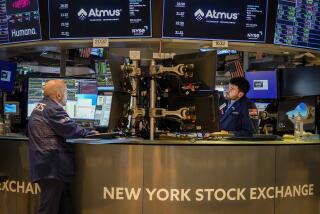The next financial crisis

Five years ago, this week, the world of finance and economics changed forever.
At least that’s the story.
It started with a sad milestone in Wall Street history: the fall of the House of Lehman.
Between Sept. 13 and Sept. 20, 2008, Lehman Bros., the legendary 158-year-old Wall Street firm, wobbled, stumbled and finally ceased to exist. In the conventional narrative, the failure of Lehman and the equally storied trading outfit Bear Stearns was part of an epic, once-in-a-generation meltdown in which global financial markets collapsed simultaneously in ways that nobody could have possibly foreseen.
But some people did foresee the disaster. I was one of them.
In July 2007, shortly after the Dow Jones industrial average crossed 14,000 for the first time, I wrote a column for this page with the headline “14,000 reasons to be skeptical.” My point was that if you looked through the euphoria and focused on the wild flows of capital and massive increases in debt, it looked like a classic bubble. And history does not treat bubbles kindly.
Although I didn’t know the bubble would burst immediately, within a month the Dow had fallen more than 1,000 points to less than 13,000. From there, the rout was on.
By the time the real crisis hit and Lehman and Bear Stearns imploded, the Dow was below 10,000. The S&P 500 index was down almost 30%. The market was waiting for more bad news.
But that was five years ago. Surely in the intervening half a decade we’ve made the necessary changes to create safer financial markets that aren’t as susceptible to damaging excess and are insulated enough that they can’t crush the overall economy?
In a word, no. Indeed, there have been practically no structural changes in our financial system at all. The systemic risks of another bubble booming and busting remain as acute as they were five years ago. All that’s different, for now, are the surrounding economic conditions.
Bubbles develop when a glut of capital ends up chasing increasingly scarce assets. In 2007 and 2008, the bubble was in corporate and consumer debt. As interest rates fell, investors turned more and more to riskier ventures in the hunt for yield.
This was readily apparent in the private-equity business, where banks were throwing so much money at takeover deals that the private-equity partnerships couldn’t put it all to work. Banks usually are pretty staid investors, and private-equity funds typically have to go searching for cash. This was definitely a dramatic turn of events.
The bubble also was clear in consumer debt markets. Remember zero-down-payment subprime mortgages? They were a pretty good clue. Remember when the average household debt increased for two straight years, peaking at $18,285 in the fourth quarter of 2007? Another hint. The idea that millions of people were watching TV shows with names like “Flip This House”? Dead giveaway.
With historic amounts of capital moving in increasingly risky directions, it was only a matter of time before the system caved in on itself. That’s essentially what happened.
Today, capital is not racing through the economy. Household debt is down 12% from its peak in 2008, as Americans pay off their ballooned credit card debt and auto loans. Corporate spending is only just beginning to rebound from a dismal retrenchment that severely depressed wages and further squeezed consumers.
The sense of mania and euphoria of five years ago has been replaced by a somber hopefulness. The S&P 500 is near its all-time high. But with the economy the way it is, we don’t feel like celebrating.
The real problem, however, is that we haven’t responded to the lessons of five years ago by making substantive changes. Banks that were deemed “too big to fail” by the federal government during the crisis — Bank of America, Citigroup and JPMorgan Chase — remain, well, too big to fail. Wall Street is back to creating synthetic collateralized debt obligations, one of the more pernicious varieties of securities that blew up during the crash. And some consumers can still get a federally guaranteed mortgage with just 3.5% down.
The point is that although the economic conditions for a bubble haven’t yet materialized, the seeds of our destruction are still there, lying dormant. And with the same financial system in place, another crisis essentially is waiting to happen.
There are no simple answers. It will take a complex plan to seriously regulate a system that affects the broader economy in ways that it never has before and is dominated by banks the size of sovereign nations.
These challenges are going to require creative measures and fresh approaches. The organization I work for is funding economic research on ideas and theories that counter the so-called neoclassical views that have long provided the intellectual backbone for our expansionary financial system. I could tick off the names of researchers around the world who are doing important work on financial stability and the way economies behave that could help foster this transformation. But I think even they would admit that it’s not enough.
Lasting change will only come with a new economic mind-set. It will take a monumental shift in the way political leaders, central bankers, business executives and regulators view policy and the world around them.
Unfortunately, no such movement appears on the immediate horizon. So in the meantime, it would be wise to be on the lookout for the warning signs of the next crisis. Heed the lessons of the past. Because by all appearances, those in power haven’t.
Eric J. Weiner is senior editor and director of communications at the Institute for New Economic Thinking and the author of “The Shadow Market.”
More to Read
A cure for the common opinion
Get thought-provoking perspectives with our weekly newsletter.
You may occasionally receive promotional content from the Los Angeles Times.






